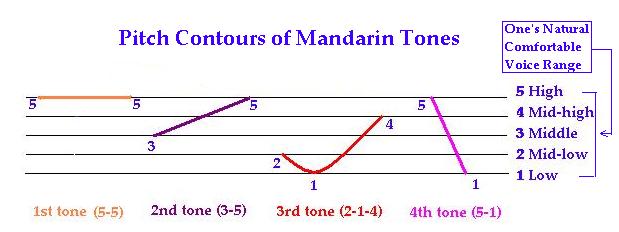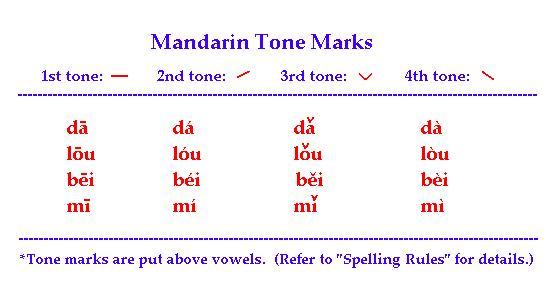Some Mandarin speakers may have problems discerning tones: I know how to say "來" (come) perfectly well, but which tone is it in after all, and is it just me or "不" does sound different in "不對" (not correct) and "不難" (not difficult), for example. If this is the case with you, read the following closely. Some of the most commonly heard tonal changes in speech are discussed here.
Single Tones
11
- Pitch Contours of Mandarin Tones
11 - Tone
Marks
11 - Examples
Tones in Combination
11
- The Neutral Tone
11 - The Full
3rd Tone and the Half 3rd Tone
11
- 3rd
+ non-3rd Combination
11 - 3rd + 3rd Combination
11 - A String of 3rd Tones
11 - 4th + 4th Combination
11
- "一"
(yī; one) and "不"
(bù; no/not)
How
to Discern Tones
11 - Compare
and contrast
Pitch Contours of Mandarin Tones
Mandarin has four basic tones* , the pitch contours of which are shown below.

* The
Chinese for the four tones are 一聲,
二聲, 三聲,
and 四聲. (聲:
shēng)
Play audios
to the right to listen to each row of four tones of the same syllable
pronounced one by one from left to right, and play audios at the bottom
to listen to each column.
| mā | má | mǎ | mà | |
| dā | dá | dǎ | dà | |
| bāo | báo | bǎo | bào | |
| pēng | péng | pěng | pèng | |
| oo |
The Neutral Tone
- The second characters in
the word below are all pronounced in the neutral tone -- "輕聲"
(qīngshēng) in Chinese.
桌子 (zhuō.zi; desk) 誰的 (shéi.de; whose) 耳朵 (ěr.duo; ear) 記得 (jì.de; remember)
- The tone mark is usually omitted to indicate that a certain syllable has a neutral tone. Many dictionaries and textbooks also put a dot before a syllable in the neutral tone -- in this web site, we will follow this convention.
The Full 3rd Tone and the Half 3rd Tone
As is shown in the Chart of Pitch Contours of Mandarin Tones, a full third tone should begin from mid-low to low and then rise to mid-high pitch. But in spontaneous speech, the third tone is rarely pronounced in full. Say the following phrases/words as naturally as you can.
特別好 (tèbié hǎo)
(exceptionally good)三百 (sānbǎi)
(three hundred years)課本 (kèběn)
(textbook)You will probably find that "hǎo", "bǎi", and "běn" did not rise at all when you said them. Instead, they started and stopped low. A third tone pronounced in this fashion is called a half third tone, because only the 2-1 part of the 2-1-4 full third tone contour is produced. Nevertheless, the tone mark remains the same in writing.
First, think about the tonal contour of the full third tone, and pronounce "好" (good; hǎo).
Now say the four words below, paying special attention to how you pronounce"好" in these words.
好吃 (3rd + 1st)
(tasty; hǎochī)好人 (3rd + 2nd)
(nice person; hǎorén)好看 (3rd + 4th)
(pretty; hǎokàn)好吧 (3rd + neutral)
(all right; hǎo.ba)You will find that in these four words, "好" is pronounced in the half third tone -- there is no rising. Examples like this abound in speech: "每年" (měinián; every year), "老師" (lǎoshī; teacher), "眼睛" (yǎn.jing; eye) ...
Conclusion:
In speech, 3rd + non-3rd => half 3rd + non-3rd.
The tone mark remains the same in writing.
Now try these:
很好 (hěn hǎo)
(very good)老虎.(lǎohǔ)
(tiger)The "很" and "老" are neither pronounced in a full third tone, nor in a half third tone. Instead, their tonal pitch contour is the same as that of a second tone, like "來" (lái; come). And notice that 好 (hǎo) and 虎.(hǔ) are both in the half third tone.
Conclusion:
In speech, 3rd + 3rd => 2nd + 3rd.
The tone mark remains the same in writing.
Consider this: 我只有兩本法語書. (Wǒ zhǐ yǒu liǎng běn Fǎyǔ shū; I only have two French books.) Which of the following is how you will say the sentence?
Wo (half 3rd)
zhi(2) you (half 3rd)
liang(2) ben(half 3rd)
Fa(2)yu(half 3rd) shū.
Wo (2)
zhi(2) you (half 3rd)
liang(2) ben(half 3rd)
Fa(2)yu(half 3rd) shū.Both are acceptable. Notice how the sentence is divided into color-coded "groups of meaning", and how tones change accordingly.
* Things may seem a bit complex, but don't worry about this as long as you know the actual tone of a character when it is by itself, because you already have the phonologic knowledge.
You may have noticed that the two fourth tones in
作業 (zuòyè)
(homework)漢字 (Hàn zì)
(Chinese character)做夢 (zuòmèng)
(to dream)are slightly different -- the second syllable sounds more "emphatic". You are right.
When one 4th tone is followed by another in a word, the first has a 5-3 pitch contour instead of a 5-5 one. Again, the tone mark does not change in writing.
"一" (yī; one) and "不" (bù; no/not)
(1) 一/不 + 4th => 2nd yí/bú + 4th
一萬 (yíwàn)
(ten thousand)一塊 (yíkuài)
(one dollar)一半 (yíbàn)
( a half)不貴 (búguì)
(not expensive)不對 (búduì)
(not correct)不慢 (búmàn)
(not slow)(2) 一/不 + non-4th => 4th yì/bù + non-4th
一天 (yìtiān)
(a day)一生 (yìshēng)
(one's whole life)不多 (bùduō)
(not many/much)不吃 (bùchī)
(not eat)一年 (yìnián)
(a year)一群 (yíqún)
(a group of)不難 (bùnán)
(not difficult)不忙 (bùmáng)
(not busy)一晚 (yìwǎn) ***
(one night)一早 (yìzǎo)
(early in the morning)不晚 (bùwǎn)
(not late)不早 (bùzǎo)
(not early)
* "一" is pronounced in the first tone (yī) when it refers to "1", the number.
** Both the original first tone of "一" and the actual tone in speech are accepted in writing. The same holds for "不".
*** 晚 (wǎn) and 早 (zǎo) are pronounced in the half third tone here.
Compare and Contrast
If you have problems telling the tone of a character, apart from remembering the first tone is high and flat, the second rising, the third low (consider the half third tone), and the fourth falling, the most practical advice is perhaps to memorize four characters representing the four basic Mandarin tones as "model" characters. For example:
三十九歲 (sānshíjiǔ suì)
(39 years of age)And if you are not sure of the tone of a certain character, simply do some comparing and contrasting.
